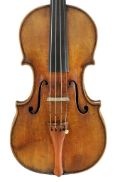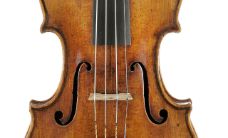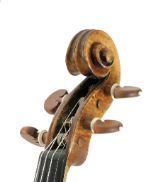Violin, Antonio Stradivari, Cremona, around 1725, “ex Smith-Quersin”
Printed label: “Antonius Stradiuarius Cremonensis / Faciebat Anno 1714” (714 handwritten)In the 1690s, Stradivari had developed a body model that was very slender and several millimeters longer than the previous model. Before 1700, Stradivari abandoned this slender model known as the long pattern and returned to building slightly shorter bodies. Until the end of his life, the master luthier continued to evolve variants of these minimally different body models of diverse lengths. The violin “ex Smith-Quersin,” might have been built on the inner mold marked “PG” and dated June 4, 1689 (Museo del Violino, Cremona, inventory no. MS 21). This model is fairly long, but has wide upper and lower bouts, letting it appear very well proportioned from an aesthetic perspective. Many instruments Stradivari made during and after his Golden Period were built on this model. The label states that the violin was made in 1714. As a dendrochronological report found that the most recent annual ring was to be dated 1713, the instrument must have been made several years later. According to the Hill brothers, it was built in 1727 based on its stylistic features. The two-piece belly has very fine to fine, regular growth rings. The one-piece, quarter-cut back displays narrow, attractive flames descending slightly toward the treble side. The structure of the rib wood corresponds to that of the back. The arching appears full and rises quickly after very shallow fluting. The f-holes are long, which is typical of Stradivari’s late instruments. The powerful scroll with its broad chamfer, which was originally blackened, is very regularly cut. A luminous, golden-yellow ground is covered with an orange-red, transparent color varnish of great brilliance.
The early history of this instrument is summarized in Jost Thöne’s encyclopedic publication about Stradivari (vol. 7, p. 130). The violin had many owners, its year of origin is unclear, and it appears in the literature with three names, which makes its history somewhat confusing. In their Stradivari monograph, the Hill brothers name Frederick Smith (1849–1914) as the owner. Industrialist Smith, who had become wealthy as a manufacturer of wire and cable, was an art lover and literature enthusiast, but also possessed a notable collection of string instruments. He purchased the violin in 1889, only to resell it to dealer Fridolin Hamma in Stuttgart in 1905. Then the Stradivari was passed on to violinist Karl Wendling (1875–1962), from whom it takes one of its names in the literature. Wendling was a student of Joseph Joachim’s and held the position of concertmaster in several renowned orchestras. He gained fame above all as the leader of a string quartet named after him. The instrument made its way to the USA via the company W. E. Hill & Sons. Roughly in 1930, it was acquired by lawyer Henri Quersin (1863–1944), who lived in Brussels. The instrument remained in the family’s possession and was played by Belgian violin player Myriam Quersin (1922–2014), who studied with Arthur Grumiaux.






